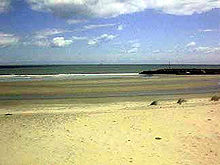
Carnsore Point (Irish: Carn tSóir or Ceann an Chairn) is a headland in the southeast corner of County Wexford, Ireland. It marks the southernmost point of the Irish Sea, on the western side of St George's Channel.
History
Ptolemy's Geography (2nd century AD) described a point called Ιερον (Hieron, "sacred promontory") which probably referred to Carnsore Point.
Grey Wexford granite from Carnsore Point, as well as Killiney Hill, Dublin was used for construction of parts of the Thames Embankment in London during the 1800s.
Energy
Cancelled nuclear project
Carnsore was proposed to be the location of a Nuclear Energy Board power plant. If built as proposed in the 1970s, the plant would have produced electricity for the Electricity Supply Board. First proposed in 1968, the then Government of Ireland gave renewed effort to the plans after the 1973 energy crisis. The plan envisaged one, and eventually four, nuclear power stations. However, the plan was dropped in the late 1970s after opposition by environmental groups, including the Wexford group the Nuclear Safety Association. The campaign against the proposed plant also gained some international support, including from Petra Kelly, who gave a speech at Carnsore. One activist against the plant who later became notable was Adi Roche, who went on to found Chernobyl Children International.
Anti-nuclear groups organised a series of rallies and concerts at Carnsore Point from August 1978 to August 1981. Titled "Get to the Point" and "Back to the Point" respectively, and featuring Christy Moore as lead act, the concerts were served to bring to public notice the question of nuclear power in Ireland. The British and Irish Communist Organisation, who believed nuclear power was necessary to achieve socialism in Ireland, picketed the first concert.
Wind farm
As of 2002, the ESB Group proposed to build a wind farm in the area. The 12 megawatt wind farm began operations in 2003.
Notes
- "Ceann an Chairn / Carnsore Point". logainm.ie. Placenames Database of Ireland. Retrieved 18 November 2022.
- C.Michael Hogan. 2011. Irish Sea. eds P.Saundry & C.Cleveland. encyclopedia of Earth. National Council for Science and the Environment. Washington DC Archived 2 June 2013 at the Wayback Machine
- "Ireland" (PDF). romaneranames.uk. Archived from the original (PDF) on 2 April 2019.
- Hyslop, Ewan; Lott, Graham (1 January 2019). "Rock of Ages. The story of British granite". buildingconservation.com. buildingconservation.com. Retrieved 19 October 2024.
- ^ Leonard, Liam; Barry, John (2007). The Environmental Movement in Ireland. Springer. p. 137. ISBN 9781402068126.
- Gioseffi, Daniela, ed. (2003), Women on War: an international anthology of Women's Writings from Antiquity to the Present, Feminist Press, p. 340
- McDermott, Veronica (2008), Going Nuclear: Ireland, Britain, and the campaign to close Sellafield, Irish Academic Press, p. 263
- Comment magazine, 8 September 1978, pp. 1–3.
- "ESB to build a wind farm at Carnsore". Irish Times. 20 February 2002.
- "Carnsore Point wind farm begins operations". Irish Times. 24 April 2003.
External links
- Nuclear Energy (An Bord Fuinnimh Núicléigh) Act, 1971
- Carnsore: Why Ireland never got nuclear power (archived 2004)
52°10′14″N 6°21′20″W / 52.17056°N 6.35556°W / 52.17056; -6.35556